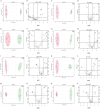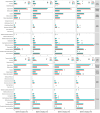Study on the mechanism of lactic acid bacteria and their fermentation broth in alleviating hyperuricemia based on metabolomics and gut microbiota
- PMID: 39698246
- PMCID: PMC11652139
- DOI: 10.3389/fnut.2024.1495346
Study on the mechanism of lactic acid bacteria and their fermentation broth in alleviating hyperuricemia based on metabolomics and gut microbiota
Abstract
Introduction: Hyperuricemia (HUA) is a metabolic disease caused by purine metabolism disorders in the body. Lactic acid bacteria (LAB) and their fermentation broth have the potential to alleviate hyperuricemia, but the potential mechanism of action is still unclear.
Methods: The LAB with high inhibitory activity against xanthine oxidase (XOD) were screened out. Then the fermentation broth, fermentation supernatant and fermentation bacteria after fermentation of these LAB were administered into HUA mice, respectively.
Results: Lactobacillus reuteri NCUF203.1 and Lactobacillus brevis NCUF207.7, of which fermentation supernatant had high inhibitory activity against XOD, were screened out and administered into HUA mice. Among them, L. reuteri strain, L. reuteri fermentation broth, L. brevis fermentation broth and L. brevis fermentation supernatant could significantly reduce serum uric acid levels and inhibited the liver XOD activity in HUA mice. The GC-MS metabolomics analysis of colon contents showed that supplementation of these four substances could partially reverse the down-regulation of energy metabolism pathways such as ketone body metabolism, pyruvate metabolism and citric acid cycle in HUA mice. It could also regulate amino acid metabolism pathways such as alanine metabolism, arginine and proline metabolism, glycine and serine metabolism, and repair the disorders of amino acid metabolism caused by HUA. In addition, the intervention of L. brevis fermentation broth and L. brevis fermentation supernatant may also accelerate the catabolism of uric acid in the intestine by up-regulating the urea cycle pathway. Fecal 16S rRNA sequencing analysis showed that their intervention increased the diversity of gut microbiota in HUA mice and alleviated the gut microbiota dysregulation caused by HUA.
Discussion: These results indicated that the LAB and their fermentation broth may play a role in alleviating HUA by regulating intestinal metabolism and gut microbiota.
Keywords: Lactobacillus brevis; Lactobacillus reuteri; gut microbiota; hyperuricemia; metabolomics.
Copyright © 2024 Rao, Dong, Chen, Liao, Wang, Fu and Wan.
Conflict of interest statement
GF was employed by International Institute of Food Innovation Co., Ltd. The remaining authors declare that the research was conducted in the absence of any commercial or financial relationships that could be construed as a potential conflict of interest.
Figures







Similar articles
-
Effect of konjac glucomannan on gut microbiota from hyperuricemia subjects in vitro: fermentation characteristics and inhibitory xanthine oxidase activity.Front Nutr. 2024 Sep 19;11:1465940. doi: 10.3389/fnut.2024.1465940. eCollection 2024. Front Nutr. 2024. PMID: 39364150 Free PMC article.
-
Skipjack Tuna (Katsuwonus pelamis) Dark Muscle Hydrolysate Ameliorates Hyperuricemia in Mice via Regulating Gut Microbiota and Serum Metabolism.J Food Sci. 2025 Apr;90(4):e70232. doi: 10.1111/1750-3841.70232. J Food Sci. 2025. PMID: 40271800
-
Effect and Potential Mechanism of Lactobacillus plantarum Q7 on Hyperuricemia in vitro and in vivo.Front Nutr. 2022 Jul 6;9:954545. doi: 10.3389/fnut.2022.954545. eCollection 2022. Front Nutr. 2022. Retraction in: Front Nutr. 2024 Nov 01;11:1517030. doi: 10.3389/fnut.2024.1517030. PMID: 35873427 Free PMC article. Retracted.
-
Gut microbiota remodeling: A promising therapeutic strategy to confront hyperuricemia and gout.Front Cell Infect Microbiol. 2022 Aug 10;12:935723. doi: 10.3389/fcimb.2022.935723. eCollection 2022. Front Cell Infect Microbiol. 2022. PMID: 36034697 Free PMC article. Review.
-
The gut microbiota as a target to control hyperuricemia pathogenesis: Potential mechanisms and therapeutic strategies.Crit Rev Food Sci Nutr. 2022;62(14):3979-3989. doi: 10.1080/10408398.2021.1874287. Epub 2021 Jan 22. Crit Rev Food Sci Nutr. 2022. PMID: 33480266 Review.
Cited by
-
Aggression and Justice Involvement: Does Uric Acid Play a Role?Brain Sci. 2025 Mar 2;15(3):268. doi: 10.3390/brainsci15030268. Brain Sci. 2025. PMID: 40149789 Free PMC article.
References
-
- Storhaug HM, Norvik JV, Toft I, Eriksen BO, Løchen ML, Zykova S, et al. . Uric acid is a risk factor for ischemic stroke and all-cause mortality in the general population: a gender specific analysis from the Tromsø study. BMC Cardiovasc Disord. (2013) 13:115. doi: 10.1186/1471-2261-13-115, PMID: - DOI - PMC - PubMed
LinkOut - more resources
Full Text Sources
Miscellaneous

